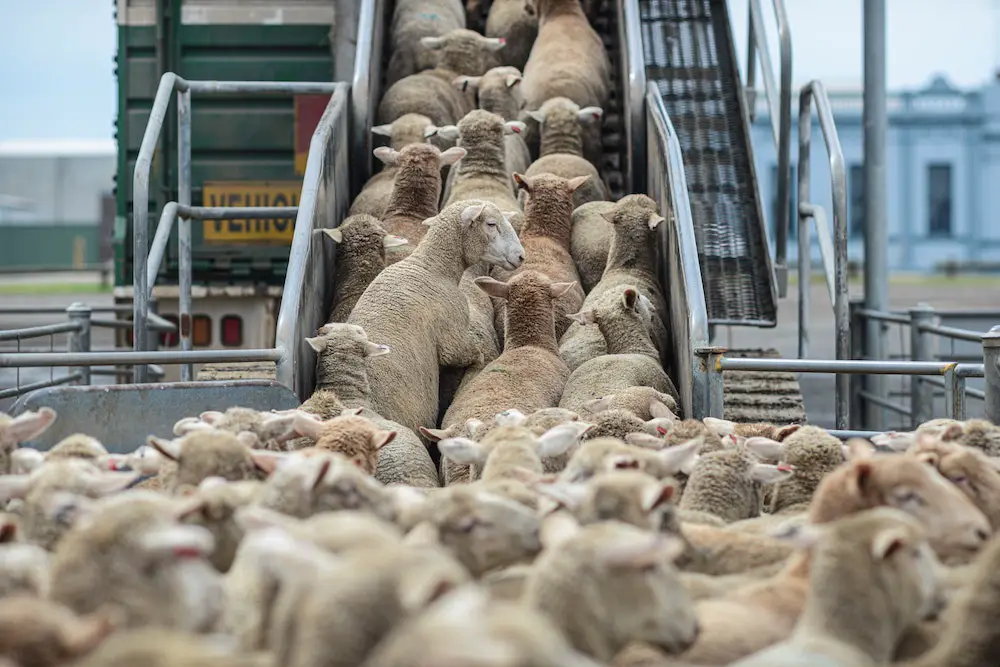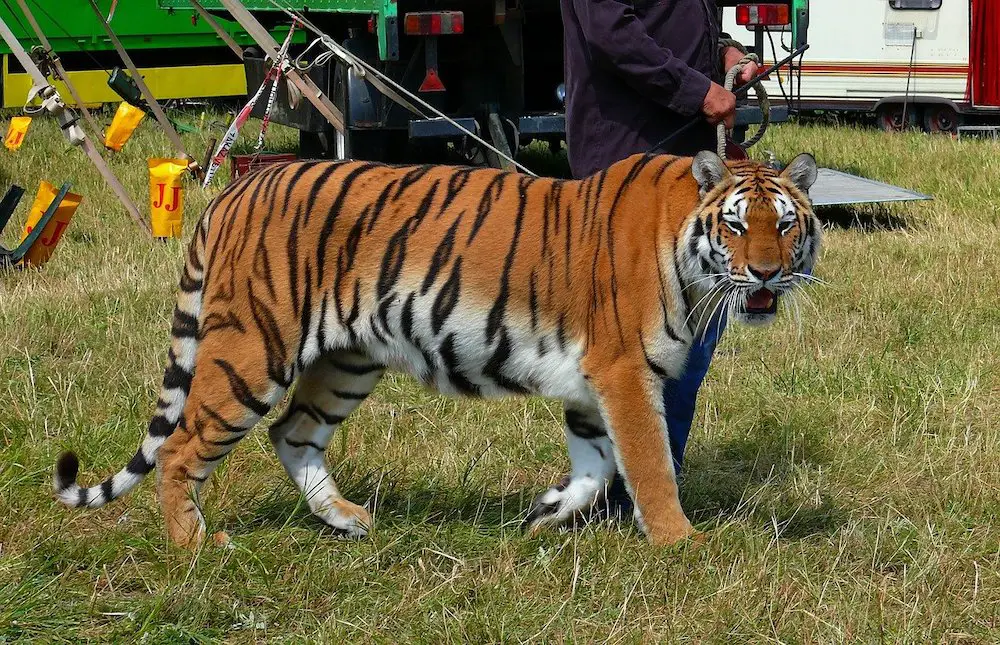Animal welfare is near and dear to many Australians. While recent trending movements in animal rights, plant-based eating, and environmental change have swept the nation, laws still remain somewhat archaic regarding animal cruelty. Today's legislation is far from perfect and written before animal rights was a salient political topic.
Australia is a unique country when it comes to animal cruelty and animal rights. Laws are designed to support factory farming and animal testing. While many organizations are fighting these laws, there is still a lot to accomplish.
Since Australia is divided into states and territories, various forms of laws exist. All of this makes universal adoption of animal rights legislation difficult and makes changing local laws a struggle. But Australians have shown this is an issue they care about, and things are changing. Read on to discover animal cruelty facts about Australia.
Two in Three Farm Animals in Australia are Factory Farmed
Every year in Australia, millions of animals are kept in inhumane factory farming conditions. These intelligent beings are denied the necessities for comfortable living. Deprived of space, adequate social interaction, and subject to abuse, these animals are used to meet the nation’s unending meat consumption.
If you don’t believe how callous and cruel these environments are, you can learn more here: Are Factory Farms Cruel to Animals?
It’s estimated that two of every three farm animals living in Australia today are subject to these poor surroundings. The factory farming model has become, by and large, the most efficient way to produce meat for human consumption. But the costs are often hidden from public view, as are the conditions of the animals.
Types of animals commonly factory-farmed:
Farming this way not only causes suffering but can also be detrimental to the environment. Meat production is by and large the most inefficient protein to produce. Unfortunately, laws meant to protect both animals and our planet often have exceptions for the factory farming industry.
Australian Animal Welfare Laws Don’t Protect All Animals
While you would be charged with hurting a dog or a cat, abusing pigs or cows is different in the eyes of Australian law. Moreover, laws are not meant to protect animals that can suffer but instead exempts animals that have a “purpose” or can be “of use.”
You might not see much difference in hitting a cat or a cow – they’re both terrible. But there is quite a difference in Australian animal cruelty laws. Some animals have a value as a “pet” or a “companion” rather than “meat” or “food,” are protected. Including:
Cows, chickens, and pigs have little to no protection from abuse. In fact, in most cases, animals in this category are treated with utter cruelty and no empathy. While animal rights groups fight tirelessly to end these arcane laws, the system is complicated.
Luckily, as awareness grows, so do people advocate the proper treatment of all animals in the country.
Each Australian State has Its Own Welfare Legislation
What makes animal welfare laws so hard to fight in the country is the lack of federal legislation. This means that every state has its own set of laws regarding the issue. While some seem pretty similar, making changes to any law means taking the fight to local states.
For example:
Additionally, Victoria, Tasmania, Western Australia, and the Australian Capital Territory all have their own animal cruelty and welfare laws. Each set of laws lays out protection for animals, but they also make “carve-out” exceptions for common farm animals.
Laws Were Enacted Without Animal Welfare Consideration
In the early part of the 20th Century, states were already placing special exemptions for farm animals for animal rights legislation. By the time the 1980s rolled around, these local laws had become widely accepted as standard farming practices. At this time, animal welfare groups were not a part of the conversation. Which means voices that would advocate for the animals were barred from:
Because the Department of Agriculture sets the laws in each state, there is an apparent conflict of interest. They need to both promote profit and scalability for farms but keep true to the morality of animal cruelty laws. An almost impossible task, and, consequently, animals are often left to suffer.
It isn’t just a point made by animal welfare advocates, it has also popped up in legal and scholarly circles in Australia. In the end. Codes of Practice are designed to ensure profits are as high as they can be regardless of costs. These costs come in the form of animal abuse, suffering, and death.
Codes of Practice Laws Protect Profits, Not Life
Codes of Practice laws have farm interests in mind. These laws ensure that costs can be as low as possible – this saves money but causes untold amounts of suffering. Farms will cut costs at every corner to ensure that the maximum profit is achieved. Practices that would make the public gasp are often hidden behind closed doors.
To keep costs as low as they can means cutting corners for animal welfare and safety. The system that may have protected these animals does not exist, so it plays out year after year.
Cutting costs means:
These cost-cutting procedures increase profit. Without them, many farms couldn’t sell their product for an attractive low price. Codes of Practice allow for this to happen. They essentially codify elements of legal animal abuse.
Lowering Costs Means Animal Cruelty
One element of the equation that often gets overlooked is consumer demands. The fact of the matter is that farms only need to implement these procedures to meet price expectations. For many Aussies, the bottom dollar cost at the store is the first thing they notice. To stay competitive means cutting costs.
We’ve learned that many of these costs come in the form of reductions in animal welfare protections. Cramped living spaces, rampant disease control, and bioengineered meat is all common practice now. So next time you head to the store, remember that those lower prices come at a cost.
Until we can change animal cruelty laws, this reality will remain. Fortunately, the days when animal rights voices were muffled is a thing of the past. Many organizations committed to taking the fight to as many states as possible.
Organizations are Fighting for Animal Rights in Australia
While farms persist with abuse of their stock, plenty of Australians are coming to combat these practices and have laws changed. Several organizations exist today with the primary purpose of protecting the rights of all animals in every state. This is no easy task as every state has separate governments and legislatures.
Even with this challenging setback, organizations are fighting for the voices of the voiceless. They include:
Most of these groups are staunch advocates of animal rights legislation. The mixture between grassroots activism and legislative lobbying has helped tip the scales toward animal equality. While there is still quite a long way to go in the country, the future has never looked brighter.
Moreover, Australia’s diverse range of animal rights groups means you can meet your level of commitment to specific groups. For those looking to implement change at a legislative level, you can do that through Animals Australia. If protesting and getting attention for the cause is more your style, Animals Liberation Australia is the right choice.
Millions of Animals are Used for Research and Testing
Factory farming has caused untold amounts of suffering to farm animals across the country. While there is no way to equate the suffering of one animal to another, we can’t forget about the millions of animals currently being used for research and testing.
Imaging which is crueler: the life of a test bunny or a caged hen is a challenging task. Often, small animals are used to perform all kinds of tests before human trials. These include:
Some of these procedures were enacted with “death as an endpoint.” In 2017 alone, almost 300,000 animals were placed in this category for research and testing. In some experiments, animals are still conscious and can feel every pinprick and every chemical burn. Some standard practices are injecting infectious diseases and placing harsh chemicals on bare skin.
While data is often shared with government entities, not all states in Australia practice this. Usually, partial data is received, so a complete picture of what is happening in labs is unclear. Moreover, there is little to no oversight to vet the quality of the data or the labs themselves.
Although cosmetic testing was banned on 1 July 2020, Australia is still the 4th largest user of animal testing in the world – so there is a lot of work still to be done. If you want to find out more, read on here: 6 Must Know Animal Testing Facts in Australia
A Quarter Million Cats and Dogs are Euthanized Annually
Animal abuse is more than just farms and labs; it also happens at home. While groups across the country desperately try to manage the stray animal population, it is not enough. Every year a quarter million dogs and cats are euthanized to make space for new animals.
Sources of excess animals:
When it comes to breeders, little exists in the form of regulation. Groups in the country, like the RSPCA, are trying to tackle the issue, but it's challenging to manage. Blame gets placed on breeders by pet shop owners, and governments blame pet shops for sourcing less than ethical puppies.
The RSPCA has taken to performing raids of suspected unethical breeders. It is a difficult process as some breeders are hard to track. However, with estimates ranging in the thousands for puppy and kitten mills in Australia, they have their work cut out for them.
The UK is another country that has a similar problem with animal cruelty. If you live there, you will want to know what we have to say: 9 Animal Cruelty Facts in the UK You Need to Know
Different Laws Exist for Exotic Animals in Circuses
If you go to a zoo on a sunny day to see the tigers, you’ll probably notice a few things:
Zoos have to meet the requirements set by specific laws regarding animal welfare. They do the best they can to keep animals protected, healthy, and happy. But what happens when you move the venue?
A unique part of the laws protecting exotic animals is where they happen to be. For an elephant, a zoo is a safe environment. Change the location to a circus, and it might be a different story since these animals are recognized under Codes of Practice.
Unfit conditions, cramped quarters, and aggressive containment tactics are all fair game. This is one of the many reasons why circuses are so cruel to our animals. Don’t get us wrong – go to the circus, just don’t support any that use animals.
While groups like Animals Australia are fighting to change legislation regarding zoo animals, it is as much of a struggle as tackling factory farming. Fortunately, there is some public momentum behind the cause. Moreover, some international circus organizations, like Cirque du Soleil, have already committed to removing animals from their acts.
It’s a relief that Australia implements good laws and practices in their zoos, but it’s not necessarily standard practice across the world. Find out why zoos are often so cruel: Are Zoos Cruel to Animals?
More and More Australians are Going Plant-Based
While organizations fight the difficult battle of changing laws and bucking the massive moneymaker that is the agricultural industry, there are things you can do in your everyday life to make a change. For most Aussies, it's easy enough to miss a few meals with meat and substitute a plant-based meal.
It’s not just ethically sound; it’s also a big moneymaker. Australia is the third-largest growing market for vegan and plant-based products in the world. The amount of money flowing into vegan brands is estimated in the hundreds of millions.
This trend is also matched with a drive for consumers to be more health conscious. Factory farming practices are no longer as in the dark as they were in the past. As a result, the future for Australia's animals looks brighter than before. With simple choices, everyday Aussies can be part of the fight.
You might be wondering if it’s worth eating meat at all, knowing how unethical the farming industry can be. Here’s a really great read to help you understand your options better: Is It Cruel to Eat Animals?
Wrapping Up
Not only does Australia have a history of animal rights missteps and cruel abuse in farms, but it is also codified in the animal rights and welfare laws. Often, the most vulnerable farm animals are excluded altogether from protection.
While this was the country’s past, a new wave of Australians fight to make sure it's not the future. The most important thing is to continue spreading information as widely as possible. The more people are aware of the issues faced with animal welfare legislation, the most power goes behind making a change.



